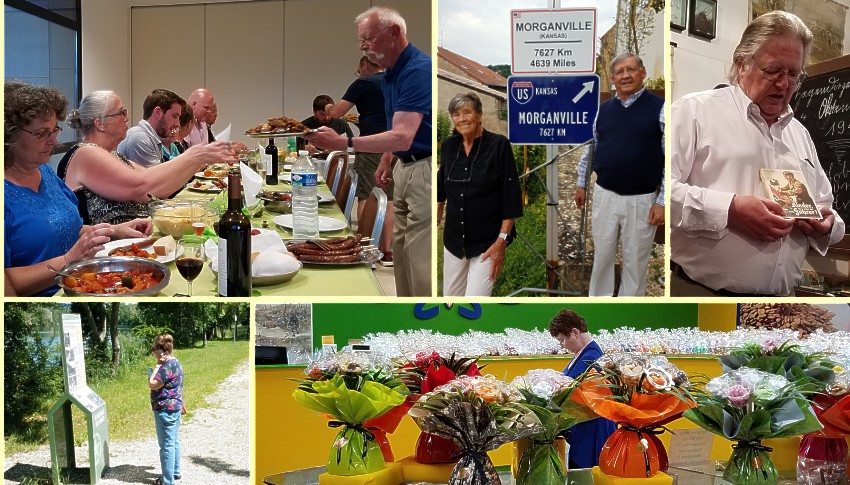Kansas Snapshots by Gloria Freeland - July 12, 2019
Two very uncommon weeks
In mid-June, husband Art and I spent two weeks chauffeuring seven others in a nine-passenger van to sites in France, Germany,
Luxembourg and Belgium. Two others joined us for about half that time, driving their own car. While Art served as our leader, I
“brought up the rear,” counting heads to make sure no one was left behind.
Art had traveled to these countries in the 1980s, and he and I have visited them every year since 2014, when we began researching
the story about Morganville, Kansas adopting Fèves, France after World War II. We thought it would be fun to share things we love
about the area with others, and the idea of taking a group with us began percolating.
Months before we left, Art made flight and hotel reservations for most of those involved. Once those commitments were made, he began
feeding the group detailed information about what to expect at airports, international travel tips, what adapters they would need
for their various electrical devices, urging them to install WhatsApp on their smart phones so they could communicate with us and
family members back home, the type and quantity of clothing to pack, how much money to have available, the weight limit for baggage,
and so on.
We were an eclectic group. It included Art’s daughter Karen and grandson Josh, my high school friend Sherri, Sherri’s nephew Cody,
university friends and colleagues Deb and Lou, and friend Jay. Jay played the part of a Native American in the 1948 pageant play in
Morganville that helped raise money for Fèves. Margretta, who portrayed a Norwegian girl in the play, and her son Ben, an airline
pilot, were with us for only part of the trip because airlines don’t like to have pilots on vacation for long during their peak season.
Margretta has an additional connection with the Morganville-Fèves story as she is the niece of Velma Carson, the author of the play
script.
Before we arrived in France, Art had set just two definite itinerary items - a visit to the ASCOMEMO museum devoted to the history
of the Lorraine region during World War II and a tour of the Hackenberg, a fort on the Maginot Line. We had ideas for other sites,
but wanted the flexibility to adjust to weather conditions and also allow serendipity to determine what we would do each day.
Our Metz hotel, similar to U.S. Extended Stay hotels, had small kitchenettes in each room, which allowed people to cook if they
wished. It was just a block from The Centre Pompidou, a modern art museum. Several of us spent an afternoon wandering through the
exhibits and trying to figure out what some of them meant.
Metz’ old town featured outdoor cafés, pastry shops and gelato stands; a covered market filled with fish, meats, flowers, cheese,
vegetables, fruit and specialty items; and the magnificent Gothic Saint-Étienne Cathedral. I noticed a concert poster on our initial
visit to the cathedral. A few nights later, we attended the performance, complete with 90 choral members and 70 instrumentalists.
We also went to Cora, a large chain store similar to Walmart, on the outskirts of Metz. It was fun to see the group’s reactions to
the extensive wine and cheese aisles and to do what we could to translate the ingredients in various food items.
We spent a day in Trier, Germany, exploring the Roman baths, amphitheater and Porta Nigra; the gardens of the rococo palace; the
cathedral; and the old market area filled with modern stores.
We visited the large World War I cemetery at Fort Douamont near Verdun, France; the largest American World War II cemetery in Europe
near St. Avold, France; the site of the ill-fated Dornot river crossing south of Metz, and the Battle of the Bulge memorial and museum
near Bastogne, Belgium. Our fellow travelers were as moved as we had been the first time we saw them.
At Bastogne, most stayed at the museum, while Art, Sherri and I drove to the Ardennes American Cemetery and Memorial at the edge of
Neupré, Belgium. I wrote a column in 2015 about Sherri's Uncle Floyd’s service and visiting his
grave. Sherri told me then that seeing it herself was on her “bucket list.” It was an emotional moment as we approached her uncle’s
cross.
In addition to these activities, our Luxembourger friend Francis took us on a winery visit and a several-hour tour of Luxembourg City.
We went on a factory tour of a dragée factory in Verdun and bought some of its famous sugar-and-chocolate-covered almonds and other
candies to take home to family and friends.
Among the most popular of the activities was a tour of Fèves, followed by being the guests of honor at a dinner with more than
30 members of the Fèves community. They now understand a bit more about the Morganville-Fèves story and what Art and I mean when
we talk about the warmth and hospitality of our French friends. The meal of couscous, sausages, meat on skewers and bread was capped
with an array of the most beautiful desserts. Of course, wine and the local Mirabelle brandy were in plentiful supply.
The days were full, and time passed quickly. All too soon, the day arrived to pack for the trip back home. Since Art and I were
staying in Europe longer, we inherited leftover wine, cheese, lunch meat, toilet paper and other items. Some struggled to
fit all their newly-purchased treasures - candy, wine, glassware, jewelry, knickknacks - into their bags, but they all managed to
stay within the weight limit.
It was hard to say “au revoir” when it was over and now we are again scattered. The post-trip reports indicate everyone had a great
time, as did we. But although we are apart, we will always have in common these two very uncommon weeks.

